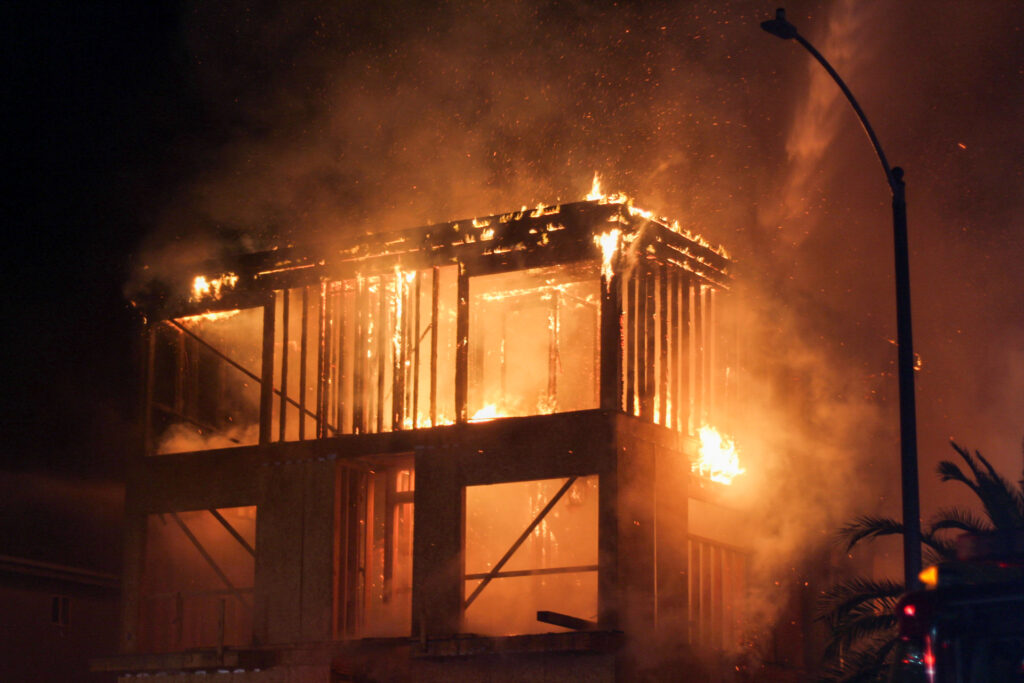
In the 10 minutes Kareen Boyadjian had to evacuate her Pasadena home in the face of the recent Eaton Fire, she was endlessly thankful that she had just returned from a trip abroad.
“I had been overseas for four and a half months, and I had a packed suitcase that I hadn’t unpacked yet,” the Point Loma Nazarene University alumna said. “So, I just grabbed that packed suitcase, my laptop and my passport and left.”
Despite the extra time this pre-packed bag allowed her to gather her most valuable belongings, she still forgot one essential item in her scramble to evacuate: her contact lenses.
This was the first wildfire Boyadjian had experienced. Her mind was racing, panicking. She hadn’t imagined she would be in this situation just an hour earlier, at dinner with her family at a local restaurant. Then the evacuation order blew up their phones, and they had to rush back home, where the only light source emanated from the encroaching fire on the hill that had cut the neighborhood’s power.
One could hardly blame her for forgetting her contacts.
“We didn’t think this was going to happen to us,” Boyadjian said. “A lot of my friends didn’t even have time to grab anything.”
Though the Eaton, Palisades and Hughes wildfires in the Los Angeles area – along with the closer Border 2 fire that charred San Diego’s Otay Mountain – have since been extinguished, fires continue to crop up across the state. To fast-track wildfire prevention projects, Governor Gavin Newsom proclaimed a state of emergency on March 1.
The lives of Boyadjian and her family, along with their home, were spared from the recent devastation. That being said, the threat of future wildfires is always looming. On March 25, California unveiled a new map of fire hazard severity zones in San Diego County for the first time in more than a decade, revealing a 26% increase in high-risk acreage. The experiences of Boyadjian and those in her Pasadena community serve as a reminder to all Californians that now is a better time than later to brush up on their fire safety and prevention knowledge.
“I think we have to stop thinking that wildfires are rare occurrences that will not affect us and realize that we are all vulnerable,” Mike Mooring, PLNU biology professor, said. “No one likes change, but climate change is a change we need to acknowledge and work as a regional and global community to mitigate and prepare for.”
Ultimately, Boyadjian’s neglecting to grab her contact lenses amounted to a relatively minor inconvenience. Without taking the time to determine which of one’s belongings are most important before a wildfire is at their front door, however, they run the risk of forgetting something truly essential.
The California Department of Forestry and Fire Protection, also known as Cal Fire, developed a mnemonic device for this situation. In the event of an emergency evacuation, they recommend to remember to collect the six P’s: people and pets; papers, phone numbers and important documents; prescriptions, vitamins and eyeglasses; pictures and irreplaceable memorabilia; personal computers, hard drives and disks; and “plastic,” referring to credit cards, ATM cards and cash. Put simply, these are people/pets, papers, prescriptions, pictures, personal computers and plastic.
Cal Fire further advises households to put together emergency supply kits, or “go bags,” containing the aforementioned items in addition to first aid materials, flashlights, clothing, food and water. They suggest the assembling of two such kits – one for the home and one for the car.
In the aftermath of her first brush with a wildfire, Boyadjian learned some further tips to keep in mind in the event of a future one. For those who haven’t already prepared a go bag, she recommended grabbing a laundry basket, as it’s already full of clothes and easy to carry. Through social media, she discovered the Watch Duty app, a non-profit fire-tracking resource operated by active and retired first responders and reporters. The app displays a map showing nearby wildfires, sends alerts based on one’s location and lists an exhaustive amount of pertinent data.
“That’s where I was able to track how close [the fire] was to my house,” Boyadjian said. “As it got closer, I could even touch a single house above my street, where I was able to see [if the house had] power and track all that kind of stuff.”
While San Diego County, on the whole, is no stranger to wildfires, PLNU’s campus, in particular, according to Assistant Director of Public Safety Kaz Trypuc, has historically not been at significant risk to this threat. Combustible brush does flourish in the adjacent Sunset Cliffs Natural Park, and Trypuc said that his team called the fire department recently after spotting fireworks going off in that area.
In the event of a wildfire on or near campus, Trypuc said that the school’s emergency alert system will send out a text message to all PLNU students and staff, informing them about the emergency and identifying the safest nearby evacuation point.
Though PLNU does not have a history with major wildfires, many smaller fires have ignited over the years, causing no injuries. In one instance several years ago, a scooter battery plugged into an outlet in the university’s Wiley Hall and burst into flames.
“Everyone evacuated safely, but that fire and the resulting water damage from the sprinklers cost tens of thousands of dollars in damage, and certainly inconvenienced all the students who then had to vacate those rooms while [they were] repaired,” Trypuc said. “Thankfully, the sprinkler system worked, and nobody was hurt. The fire was able to get extinguished, but, at the same time, that tells you how significant of a risk a potential fire in a residence hall can be.”
To mitigate the likelihood of domestic fires, PLNU Residential Life prohibits students from bringing candles, lava lamps and other flammable items into their dorm rooms. Inevitably, however, fires still happen. Knowing how to respond to them can be life-saving.
“If anyone sees a fire, they should immediately call 911 [and] get to safety,” Trypuc said. “Second, if it’s safe to do so and it’s a small enough fire, grab a fire extinguisher. If they’re in a building, pull a fire [alarm] so it alerts other people that there’s a fire as well.”
Trypuc further recommended that anyone who sees frayed wiring, a buildup of materials blocking an emergency exit or any general hazard in a campus building should contact Campus Facilities at (619) 849-2320 to address the issue. Though small fires, including another Trypuc mentioned that took the Nicholson Commons dishwashing operations offline for months, have affected PLNU, the goal is to minimize the potential for them to ignite.
“Thankfully, nobody’s been hurt in any of these, but that’s never guaranteed,” Trypuc said. “You want to make sure you get these things extinguished quickly. It impacts the campus. It takes dining services offline or it displaces students at a residence hall. Even a fire that’s put out pretty quickly can still have an impact for a long time after.”
Most people have been taught to stop, drop and roll, install smoke detectors and not leave lit stoves unattended. However, Californians see in the news and social media that fires erupt in their proverbial backyards – if not their literal backyards – every year. As Boyadjian can attest, it is in one’s best interest to be prepared before it’s too late.
“It’s crazy driving around in our neighborhood every single day and seeing houses just gone,” Boyadjian said. “It’s heartbreaking.”
